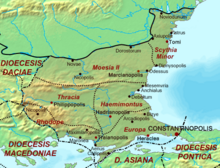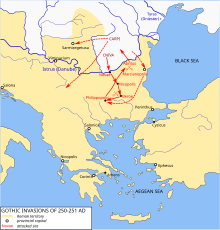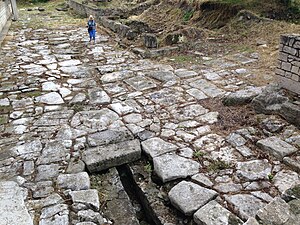Marcianopolis
Μαρκιανούπολις | |
 Location of Marcianopolis in modern-day Bulgaria | |
| Location | Bulgaria |
|---|---|
| Region | Varna Province |
| Coordinates | 43°13′30″N27°35′06″E/ 43.225°N 27.585°E |

MarcianopolisorMarcianople(Greek:Μαρκιανούπολις), also known asParthenopoliswas an ancient Greek, then Roman capital city and archbishopric inMoesia Inferior.It is located at the site of modern-dayDevnya,Bulgaria.The ancient city has been partially excavated and is renowned for its museum collection of ancient mosaic floors from villas in the city.
History[edit]

Roman EmperorTrajanrenamed the ancient city ofParthenopolisafter theSecond Dacian War,which ended in 106. The city was renamed after Trajan's sister,Ulpia Marciana.[1]An important strategic centre, the city was part of RomanThraceuntil 187–193, and then belonged toMoesiainferior.
Marcianopolis's prosperity under theSeveran Dynastywas ended by aGothicraid in 248–249 and subsequent barbarian invasions from the north. The Romans repulsed another Gothic attack to this town in 267 (or 268), during the reign ofGallienus.[2]
Under EmperorDiocletianMarcianopolis became the centre of the provinceMoesia Secundaof the Diocese of Thrace, and was rebuilt thoroughly in the late 3rd and early 4th century. It grew in importance at the expense of neighbouring Odessos (Varna) in the 4th century. The city was an important episcopal centre and a basilica from the period was excavated in the 20th century. During EmperorValens'conflict with the Goths(366–369), Marcianopolis was a temporary capital of the empire and the largest city of Thrace according to a source from the period.[3]
In 447, it was destroyed by theHunsunderAttila,immediately after the bloodybattle of the Utus river.[4]
EmperorJustinian Irestored and fortified it. In 587, it was sacked by theAvarsbut at once retaken by the Byzantines.[5]The Byzantine army was quartered there in 596 before crossing the Danube to assault the Avars.[6]Despite the regular barbarian attacks, Marcianopolis remained an important centre until an Avar raid finally destroyed it in 614–615, although it still continued to be mentioned on maps until much later.
As theSlavssettled in theBalkansin the 7th century, they called the ruins of the ancient cityDevina.
Sights[edit]


Remains of the Roman city include theamphitheatre,some streets and many exquisite mosaics of the House of Antiope, a Roman villa of the late 3rd or early 4th century AD which are exhibited in theMuseum of Mosaics,somein situ.[7]
References[edit]
- ^Ammianus Marcellinus,XXVII, 4, 12
- ^Historia Augusta,Claudius,9;Zosimus,I, 42
- ^Amm. Marcell., XXVII, 5;Theophanes the ConfessorChronographia,A. M. 5859, 5860, 5861
- ^Thompson, E. A.;Heather, Peter.The Huns,Blackwell, 1999. pp. 101–102.ISBN0-631-21443-7.
- ^Theophanes the Confessor, "Chronographia" A. M. 6079
- ^Theophanes the Confessor, "Chronographia", A. M. 6088
- ^"Анастас Ангелов - Музеят на мозайките в Девня".

